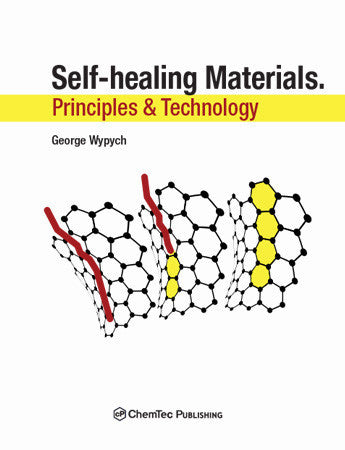Self-healing phenomenon, adapted from living things, was for a long time an interesting topic of discussion on the potential improvements of human-made products, but for quite a while it became applicable reality useful in many manufactured product.
The book has three major sections organized in fifteen chapters. The first section contains chapter which discusses the well-established mechanisms of self-healing which can be potentially applied in the development of new materials that have an ability to repair themselves without or with minimal human intervention. All theoretical background required and known to-date to understand these principles is included in this section. The full chapter on chemical and physical changes which occur during self-healing are also discussed and it belongs to this section.
The second part of this book compares parameters of different self-healing technological processes. The process parameters discussed include fault detection mechanisms, methods of triggering and tuning of the healing processes, activation energy of self-healing processes, the means and methods of delivery of the healing substances to the defect location, self-healing timescale (rate of self-healing), and the extent of self-healing (healing efficiency, recovery of properties, etc.). Each of these topics is discussed in a separate chapter.
The third part is devoted to the mathematical modeling of the processes of self-healing (molecular dynamics simulation), the morphology of healed areas, and the discussion of application the most important analytical techniques to the evaluation of the self-healing process.
The final section of the book includes practical advice on the selection of additives for self-healing formulation, methods of self-healing of different polymers and application of self-healing technology in different groups of the products. This part is based on the practical knowledge, the existing patents, the published paper, and the practical application notes. Thirty polymers and twenty-seven groups of products are selected for this discussion based on their frequency of application of the technology of self-healing.
The expected audience for this book includes people working in the industries listed in chapter 15 and on the polymers listed in chapter 14 (see the table of contents below), university professors and students, those working on the reduction of wastes and recycling, and all environmental protection agencies.
1 Introduction. Lessons from Living Things
2 Mechanisms of Self-healing
2.1 Autonomic
2.2 Click chemistry
2.3 Crosslinking
2.4 Hydrogen bonding
2.5 Luminescence
2.6 Morphological features and organization
2.7 Shape memory
2.8 Thermal healing
2.9 UV
2.10 Water
2.11 Other mechanisms
3 Chemical and Physical Processes Occurring During Self-healing of Polymers
3.1 Chemical reactions
3.2 Compositional changes
3.3 Physical processes
3.4 Self-assembly
4 Fault Detection Mechanisms
5 Triggering and Tuning the Healing Processes
6 Activation Energy of Self-healing
7 Means of Delivery of Healant to the Defect Location
7.1 Autonomous
7.2 Capsule and vascular carriers
7.3 Environmental conditions
7.4 Liquid flow
7.5 Magnetic force
7.6 Manual injection
8 Self-healing Timescale
9 Self-healing Extent
10 Molecular Dynamics Simulation
11 Morphology of Healing
12 Selected Experimental Methods in Evaluation of Self-healing Efficiency
12.1 X-ray computed tomography
12.2 Raman correlation spectroscopy
12.3 Raman spectroscopy
12.4 Impedance spectroscopy
12.5 Water permeability
12.6 Surface energy
13 Additives and Chemical Structures Used in Self-healing Technology
13.1 Polymers
13.1.1 Urea-formaldehyde resin
13.1.2 Polydimethylsiloxane
13.1.3 Ureidopyrimidinone derivatives
13.1.4 Epoxy resins
13.1.5 Polyaniline
13.1.6 Polyurethane
13.2 Capsule-based materials
13.3 Catalysts
13.4 Chemical structures
13.5 Coupling agents
13.6 Crosslinkers
13.7 Fibers
13.8 Magneto-responsive components
13.9 Metal complexes
13.10 Nanoparticles
13.11 Plasticizers
13.12 Solvents
13.13 Vascular self-healing materials
14 Self-healing of Different Polymers
14.1 Acrylonitrile-butadiene-styrene
14.2 Acrylic resin
14.3 Alkyd resin
14.4 Cellulose and its derivatives
14.5 Chitosan
14.6 Cyclodextrin
14.7 Epoxy resin
14.8 Ethylene-vinyl acetate
14.9 Natural rubber
14.10 Polybutadiene
14.11 Poly(butyl acrylate)
14.12 Polycyclooctene
14.13 Poly(ε-caprolactone)
14.14 Polydimethylsiloxane
14.15 Poly(ethylene-co-methacrylic acid)
14.16 Polyethylene
14.17 Poly(2-hydroxyethyl methacrylate)
14.18 Polyimide
14.19 Polyisobutylene
14.20 Poly(lactic acid)
14.21 Polymethylmethacrylate
14.22 Poly(phenylene oxide)
14.23 Polyphosphazene
14.24 Polypropylene
14.25 Polystyrene
14.26 Polysulfide
14.27 Polyurethanes
14.28 Poly(vinyl alcohol)
14.29 Poly(vinyl butyral)
14.30 Poly(vinylidene difluoride)
15 Self-healing in Different Products
15.1 Adhesives
15.2 Aerospace
15.3 Asphalt pavement
15.4 Automotive
15.5 Cementitious materials
15.6 Ceramic materials
15.7 Coatings
15.8 Composites
15.9 Corrosion prevention
15.10 Dental
15.11 Electrical insulation
15.12 Electronics
15.13 Fabrics
15.14 Fibers
15.15 Film
15.16 Foam
15.17 Hydrogels
15.18 Laminates
15.19 Lubricating oils
15.20 Medical devices
15.21 Membranes
15.22 Mortars
15.23 Pipes
15.24 Sealants
15.25 Solar cells
15.26 Thermal barrier coatings
15.27 Tires
Index
George Wypych has a Ph. D. in chemical engineering. His professional expertise includes both university teaching (full professor) and research & development. He has published 17 books: PVC Plastisols, (University Press); Polyvinylchloride Degradation, (Elsevier); Polyvinylchloride Stabilization, (Elsevier); Polymer Modified Textile Materials, (Wiley & Sons); Handbook of Material Weathering, 1st, 2nd, 3rd, and 4th Editions, (ChemTec Publishing); Handbook of Fillers, 1st, 2nd and 3rd Editions, (ChemTec Publishing); Recycling of PVC, (ChemTec Publishing); Weathering of Plastics. Testing to Mirror Real Life Performance, (Plastics Design Library), Handbook of Solvents, Handbook of Plasticizers, Handbook of Antistatics, Handbook of Antiblocking, Release, and Slip Additives (1st and 2nd Editions), PVC Degradation & Stabilization, PVC Formulary, Handbook of UV Degradation and Stabilization, Handbook of Biodeterioration, Biodegradation and Biostabilization, and Handbook of Polymers (all by ChemTec Publishing), 47 scientific papers, and he has obtained 16 patents. He specializes in polymer additives, polymer processing and formulation, material durability, and the development of sealants and coatings. He is included in the Dictionary of International Biography, Who's Who in Plastics and Polymers, Who's Who in Engineering, and was selected International Man of the Year 1996-1997 in recognition for his services to education.




